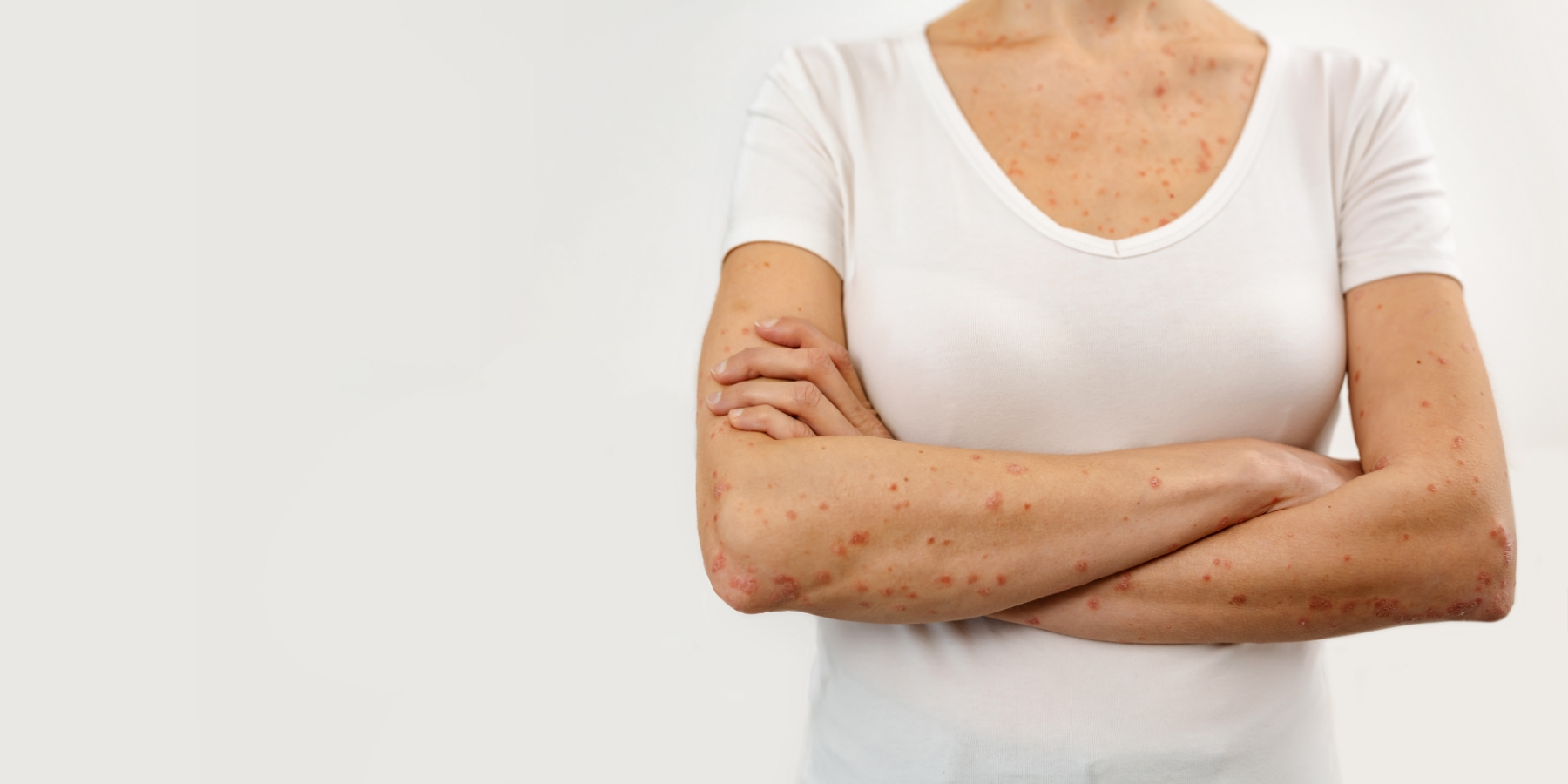
Skin allergies and rashes are widespread, accounting for more than 5.7 million doctor visits annually. Redness, itchiness, and hives might indicate a possible skin allergy. However, irritation can be caused by many factors. At Houston Skin, our board-certified dermatologists and licensed skin care providers are dedicated to helping you identify the cause of your skin concerns and provide effective medical dermatology treatments for relief.
Understanding Skin Allergies and Rashes
Skin allergies occur when your immune system overreacts to a substance that comes into contact with your skin. This reaction can lead to a variety of symptoms, including:
- Hives or welts: Raised, itchy bumps on the skin.
- Itching: An uncomfortable sensation that makes you want to scratch.
- Rashes: Changes in the skin’s appearance, such as redness, bumps, or blisters.
- Scaling: Dry, flaky skin.
- Swelling: An increase in the size of the affected area.
- Flaking: Shedding of dead skin cells.
- Oozing or weeping: Discharge of fluid from the skin.
Rashes, however, can be caused by a broader range of factors, including allergies, irritants, infections, and underlying medical conditions.eathing.
Common Causes of Skin Allergies and Rashes
- Allergens: These can include foods, medications, cosmetics, fragrances, laundry detergents, pet dander, plants (like poison ivy), and metals (like nickel).
- Irritants: These can include soaps, detergents, chemicals, and even friction.
- Infections: Bacterial, viral, and fungal infections can all cause rashes.
- Medical conditions: Eczema, psoriasis, and other skin conditions can also cause rashes.
Meet The Team
Our Houston team of Board-Certified Dermatologists and licensed skin care providers brings a wealth of experience and a passion for healthy skin. With extensive clinical experience and the highest levels of training, our doctors are committed to delivering exceptional care and achieving optimal results for every patient. We prioritize your comfort and safety, promoting a positive and reassuring experience throughout your journey to vibrant skin. We’re honored to be your trusted provider of quality medical dermatology care and your partners in achieving and maintaining your skin’s health.
Skin Allergy and Rash Treatment
At Houston Skin Associates, we take a comprehensive approach to treating skin allergies and rashes:
- Thorough Evaluation: Our dermatologists will perform a detailed examination and discuss your medical history to determine the cause of your skin concerns. This may include allergy testing or a skin biopsy.
- Personalized Treatment Plan: Based on the cause of your allergy or rash, we will create a personalized treatment plan that may include:
- Avoidance of triggers: Identifying and avoiding allergens or irritants that are causing your reaction.
- Topical medications: Creams and ointments to relieve itching, inflammation, and other symptoms.
- Oral medications: In some cases, oral medications may be necessary to control more severe reactions.
- Allergy shots: These can help manage certain types of allergies.
- Ongoing Support: We are committed to providing ongoing support to help you manage your skin condition and achieve long-term relief.
Common Skin Allergies
Allergic Contact Dermatitis
The most common type of skin allergy is contact dermatitis, which occurs when your skin comes into direct contact with an allergen. Plants like poison ivy and poison oak can cause allergic contact dermatitis and the formation of a red, itchy rash. In this case, the allergic reaction comes from touching the oily coating that covers the plant’s leaves. Contact dermatitis can also be caused by touching certain clothing fibers, pets, or jewelry made from metals like nickel.
Atopic Dermatitis (Eczema)
Atopic dermatitis is often linked to asthma, hay fever, or food allergies. It is one of the most common skin conditions, affecting both children and adults. Currently, about 17.8 million people suffer from atopic dermatitis, which often appears as a red, itchy rash on the cheeks, arms, and legs.
Urticaria (Hives)
Hives are an uncomfortable and sometimes painful allergy that occurs when the immune system is triggered to release histamine, resulting in skin swelling. Hives can have many causes, including particular foods, heat, exercise, certain medications, insect bites, or infections. While hives can cause discomfort, they are not contagious and are generally not dangerous.
Angioedema
Angioedema is another type of skin allergy that causes swelling in the deep layers of the skin. People with angioedema often suffer from hives. Angioedema most commonly occurs in the soft tissues of the body, such as the eyelids, mouth, or even genitals.
There are two types of angioedema: acute and chronic. Angioedema is an acute condition that lasts a short time (from a few minutes to several hours). Most often, acute angioedema is caused by an allergic reaction to certain foods or medications. If the angioedema recurs over a long period of time, it is considered chronic and recurrent. In chronic cases, it is difficult to determine the trigger.
Feel Good About Your Skin
Ready to unlock your skin’s full potential? Schedule a skin allergy consultation at our convenient Houston Skin locations today. Our board-certified dermatologists will provide a personalized assessment and recommend the ideal treatments to help you achieve and maintain healthy, vibrant skin. Call now or schedule a consultation online to take the first step towards a more confident, radiant you.



